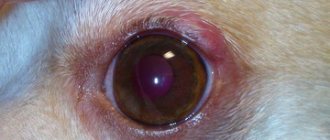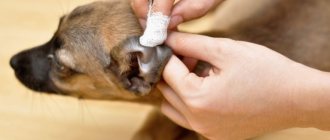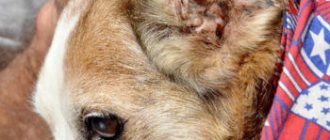Often, when owners discover lumps under their dog’s skin, they begin to panic. According to the prevailing stereotype, people associate bumps with tumors and cancer, which, in their opinion, should lead to the inevitable death of the animal. This is far from true.
If you find lumps or subcutaneous lumps on your pet, you should show it to the veterinarian, because often such formations are not dangerous and in many cases do not even require treatment.
First, the doctor will examine your dog for similar bumps all over his body. Even if there are several of them, this is also not a reason to be upset. By taking some tests, the specialist will send them to a special laboratory for testing.
There are several ways to study a lump:
- biopsy (inserting a needle into a lump and taking cells from its tissue);
- imprint (if the lump is presented in the form of an ulcer, then the glass for analysis is applied directly to it and an imprint is made);
- X-ray examination;
- CT scan.
After the examination, the veterinarian receives the results and only uses them to draw conclusions and make a diagnosis.
Lumps under the skin can be a variety of things:
- Lipomas are a widespread formation in the form of a compaction under the skin;
- cysts, hematomas, papillomas, warts and other non-cancerous formations;
- insect bites;
- ulcers;
- bruises;
- foreign bodies under the skin (dogs, while running, can run into a branch, for example, or bushes with thorns);
- benign tumors.
All of the above formations do not pose a threat to the health and life of the dog. However, in some cases it is better to remove them if the lump is growing rapidly, causing discomfort to the animal, or there is a risk of it developing into a more serious tumor.
Another type of formation under the skin is malignant tumors, cancer. If lumps of this kind are detected, treatment and surgical removal of the tumor are required, if this is possible in each specific case.
Most common locations
Cones differ not only in shape, size, color, but also in location. Some formations are detected in certain areas:
- on the neck - boils, wen, abscesses, traces of insect attacks, inflamed lymph nodes;
- on the cheek - inflamed salivary glands, an abscess due to an untreated diseased tooth;
- on the ear - hematoma, abscess, wound from an insect sting;
- on the eyelid - papilloma, wen;
- on the mammary glands – a tumor due to hormonal imbalance;
- on the extremities - hematoma or abscess; in Labradors, shepherds and other large dogs, there may be an increase in joint tissue due to increased weight load;
- under the tail - wen, papilloma, malignant neoplasm, blockage of the paraanal gland.
What are they?
The appearance of papillomas (warts) is caused by papillomoviruses of various types. They are not dangerous. The animal’s body does not perceive the virus as “foreign.” The fact is that it contains DNA, so the immune system recognizes it as part of the body. Because of this, it is impossible to completely eradicate the disease. But it’s quite possible to make her “fall asleep.”
Canine papillomavirus is not dangerous to humans. True, the disease is constantly mutating, there are many varieties, so it is difficult to say categorically about the impossibility of infection. However, it is known for sure that infection is possible only through extremely close contact. For example, when saliva gets on injured skin. Therefore, observing basic hygiene rules is guaranteed to protect against illness.
General symptoms
There is no single symptomatology, since bumps appear for various reasons:
- An abscess that occurs when pathogenic bacteria penetrate a wound is accompanied by swelling, pain, fever, and after a few days pus comes out.
- Hematomas are purple-red and do not cause discomfort.
- Warts, which often appear in terriers with smooth coats, protrude above the skin, are brown in color, and do not hurt.
- Purulent inflammatory diseases are accompanied by rashes on any part of the skin.
- After an insect bite, a painful swelling occurs.
- The cyst looks like a painful boil.
- Oncological diseases are asymptomatic in the early stages, but an advanced tumor bleeds, can become painful, and break through the skin.
Causes of bumps
A lump in a dog may be harmless, arising after a blow, attack by stinging insects, the appearance of a benign neoplasm, or it may be a symptom of oncological pathology. Some tumors go away on their own after a few days, while others require immediate contact with a veterinarian.
Reaction to insect venom or injected drug
The injected drug can cause an allergic reaction, accompanied by swelling on the dog's thigh, itching, swelling and redness of the tissue. And the appearance of bumps on a dog’s nose is provoked by the poison of bees, wasps, hornets, large ants, and spiders. The animal rolls around and scratches the affected area.
Note! It is dangerous when an insect bites you in the face. In this case, the animal may suffocate due to swelling of the respiratory tract tissues.
Usually the allergic reaction goes away on its own. The sting stuck in the skin must be removed. For severe reactions to an allergen, the veterinarian will prescribe antihistamines and anti-inflammatory medications. If a dog has anaphylactic shock, then corticosteroids, intravenous infusions, and adrenaline injections are required. They are also selected by a veterinarian.
Bee attacks dog
Gadflies can lay larvae under a dog's skin. In this case, a hole is visible on the cone through which the parasite breathes. Sometimes dogs get sick with dracunculiasis, a subcutaneous helminthiasis.
Foreign object stuck under the skin
When a small foreign object penetrates the skin, the dog feels pain. A rough puncture is visible on the skin, the bump is bleeding.
The owner should not remove the splinter on his own, even if it protrudes above the skin, since there is a high probability of infection of the wound and severe bleeding. It is only permissible to treat the affected area with an antiseptic solution. The pet must be taken to a veterinary clinic.
Failed injection
It is considered normal for a bump to appear on the back of a pet’s head after vaccination with the Nobivak rabies vaccine or microchipping, or on the paw after insertion of a catheter. If there is no discomfort from a bump on the dog's withers, surgical intervention is not required.
The dog is given a vaccine
If the lump from the injection becomes inflamed, swollen, begins to grow, darken, and irritate the animal, then urgent consultation with a veterinarian is required, since we are talking about a purulent process, the formation of an abscess.
His reasons:
- rapid squeezing of the vaccine from the syringe;
- penetration of the injection solution into the subcutaneous fat;
- improper preparation and storage of the vaccine;
- injury to a blood capillary or nerve tissue with a needle;
- allergy to the administered drug.
On a note! The abscess is dense to the touch, in the form of a ball rolling under the skin. A sick pet has a fever.
The opened abscess is washed with water. The veterinarian prescribes antiseptics and wound healing ointments. An unopened abscess is treated with anti-inflammatory drugs. If the cause of purulent inflammation is a bacterial infection, then antibiotics are needed.
Hernia
The lump on a dog's stomach may be a hernia - a protrusion of an internal organ through a tear in the muscle tissue. It occurs in the form of a soft formation or a rounded compaction with a diameter of 1 cm. Many hernias disappear on their own, but surgery is performed to eliminate a huge formation.
Important! The diet of a dog suffering from a hernia includes wet food. The animal is not allowed to strain during bowel movements.
Hematoma
The most common cause of a bump on a dog's head is injuries from hard objects. A lump on a dog’s side on the left or right can be seen after intensive scratching with claws or an accidental blow with a paw. The more damaged the capillaries are, the more convex and crimson the formation becomes.
The lump under the skin of a dog's ear swells greatly, since the skin here is thin. The cause of a lump on a dog's paw may be a torn ligament or muscle injury. At the site of the lesion, the skin becomes hot, and lymph nodes may become enlarged. If your dog has a small bump on his leg, applying a cold compress is enough. If there is a suspicion of a rib fracture or other injury, the animal is taken to a veterinary clinic.
Inflammation of the paraanal glands
The paraanal glands in dogs are a paired secretory organ that secretes an odorous substance with which the animal marks its territory. It is located at the confluence of the rectum and anus.
Inflammation of the paraanal glands
A lump on a dog's tail can be seen when the gland becomes inflamed due to blocked ducts. The inflamed area itches, becomes bald, and hurts. A rash appears on the skin of the groin, and thick discharge comes from the loop.
Causes of inflammation:
- weak immunity;
- infectious lesion;
- lack of hygiene;
- injury;
- hereditary predisposition;
- pregnancy.
Inflammation is treated by washing the glands and taking antibacterial medications. Therapy lasts about 2 weeks.
Tumors
Lumps on a dog's back can be malignant or benign.
Benign
Such formations are not life-threatening and are usually painless. If they do not grow and the pet’s health does not change, then no treatment is required.
Benign tumors in dogs are listed in the table:
| Name | Reasons for appearance | Signs |
| Papillomas | Virus | Several oblong dark bumps on the dog's face |
| Hemangioma | Failure of DNA division or vascular pathologies | Looks like a small red mole |
| Lipoma | Sebaceous gland blockage | Elastic lump with fatty contents |
| Pyoderma | Purulent dermatological disease in puppies | Pus-filled papules |
| Cyst | Hormonal disorders, poor hygiene, heredity | Loose cavitary neoplasm of white, gray or bluish color |
Cysts appear everywhere in dogs, even on the jaw and gums. A cyst on an internal organ may burst, in which case symptoms of intoxication and bouts of vomiting occur. The dog must be taken to the clinic immediately.
On a note! Benign bumps are removed with liquid nitrogen if they disfigure the appearance of the animal or cause discomfort.
Malignant
Cancer is uncontrolled cell proliferation, leading to the death of the animal.
A growth on the back of a dog can be:
- fibrosarcoma - proliferation of connective tissues;
- osteosarcoma – a neoplasm of bone tissue;
- lymphosarcoma - tumor of the lymph nodes;
- squamous cell carcinoma - a malignant formation on the skin;
- mastocytoma - a growth of immune agents, manifested by a lump on the dog’s neck, on the spine, under the armpit or on the belly closer to the groin area.
A surgeon performs an operation on a dog.
You can hope for a dog's recovery at the onset of the disease. After the tumor is surgically removed, the dog is given radiation therapy to kill any remaining cancer cells. At a late stage of the disease, when metastases have occurred, the surgical procedure is useless and chemotherapy is performed.
Note! In stages I and II of cancer, recovery occurs in 90% of cases, in stages III and IV – in 50%.
If therapy does not help, then it is more humane to euthanize the sick animal.
What diseases can cause bumps on the back and body of dogs?
The appearance of hard balls under the skin of the animal on the back, neck, tail and side indicates that not everything is in order in the animal’s body.
May arise from:
- on the nose from the bite of tick-like insects;
- injections, including vaccinations;
- blow;
- infection when bacteria enter the epidermis;
- diseases of the lymph nodes;
- vascular damage during surgery;
- viral diseases;
- metabolic disorders;
- oncological disease.
A lump on a dog’s body is a compaction ranging in size from several millimeters to several centimeters in diameter.
Such balls can appear not only on the back or stomach. Sometimes subcutaneous swelling in the area of the paws, ears, and neck may go unnoticed.
If you find at least one lump on your pet’s body, you need to examine it for the presence of others.
The most common cause of swelling on the back is:
- tumor-like benign formation – papilloma. The disease is caused by the papilloma virus and affects the epithelium of the skin;
- cyst-like compaction. Appears under the skin in the form of a capsule containing liquid;
- inflammatory process, abscess. Formed after bacteria enter the skin;
- hemorrhage, hematoma. Occurs after bruises, blows, surgery;
- Wen - accumulation of subcutaneous fat in one place. Appears when metabolic processes are disrupted;
- swelling of unknown etiology. May be benign or malignant.
Tumors are observed on the dog’s abdomen when:
- hernia - prolapse of a sac with internal organs through the intestinal plexuses;
- inguinal hernia;
- mechanical damage to the skin, with infection;
- mastitis, inflammation of the mammary glands;
- pyoderma appears in diseases of the gonads;
- perianal adenoma;
- oncological diseases of internal organs.
On the ears, face and paws there are:
- warts, smooth and vesicular;
- papillomas, growths;
- swelling from parasite bites;
Having identified a compacted area of the body under the skin of the animal, you need to observe it for a day.
If it does not go away, you should show it to the doctor.
What the owner should do when a lump is detected
Having discovered a lump, the owner must thoroughly wash his hands with a hygiene product, palpate from the side and above to understand how dense the texture of the formation is and whether there is something inside. This must be done carefully, as it may hurt the dog. If the lump looks suspicious, you need to take your pet to a veterinary clinic.
Important! You should not allow your dog to bite or lick the sore area. Otherwise, a granuloma will appear - a formation of connective tissue in the form of a hard knot.
Diagnostic measures
To make a diagnosis, the veterinarian examines the dog and prescribes diagnostic tests:
- clinical and biochemical blood tests;
- X-ray of the chest area;
- Ultrasound;
- Analysis of urine;
- computed tomography to detect malignant tissue;
- biopsy for histological examination;
- swab to detect infection;
- radiographic examination to assess the depth of tumor tissue penetration.
Carrying out a computed tomography scan on a dog
Types of papillomas
Depends on size, from 0.1 to 5 mm. A wart may go beyond this conventional “gradation”:
- Color. Various color combinations from light brown to dark yellow;
- Structure. Dense, soft, hard (sometimes rough);
- From formation on the skin. It may be ingrown or attached to a leg;
- The formations that grow on the stem literally dangle, and the risk of accidentally tearing them off is very high, especially if the wart is on the face or in the mouth of the animal;
- Those that grow into the body are dangerous because they can develop into a malignant tumor, or carcinoma. However, size and color do not affect this in any way.
If this formation is detected in a dog, it is necessary to do a blood test to make sure that there is no possible tumor. To do this, scraping and biopsy are done. You should not trust a doctor who only does an external examination. In what cases is it necessary to remove warts from a dog:
- if warts or papillomas are located in the oral cavity and can be damaged while chewing food;
- if it forms near the eye and interferes with visual functions;
- if the dog can easily touch the growth, thereby introducing an infection there;
- if there is a possible suspicion of a malignant tumor.
Preventive measures
To keep the dog healthy, the owner must follow the following recommendations:
- vaccinate your pet once a year;
- regularly bring it to the veterinarian for examination;
- choose walking areas where the animal cannot be injured;
- do not allow your pet to come into contact with stray animals;
- examine the bitch's mammary glands weekly;
- provide high-quality and balanced nutrition.
Recommendation! A dog that is not suitable for breeding should be sterilized at 6 months of age. This will reduce the likelihood of breast cancer.
If even a small bump appears, your pet should be shown to the veterinarian, because it may be the first sign of a dangerous disease. It is absolutely impossible to treat a dog on your own. Prescribed medications must be used according to instructions, without exceeding the dosage.










